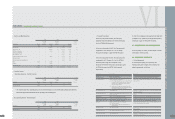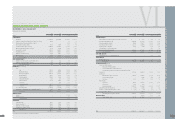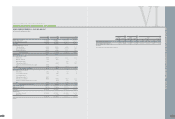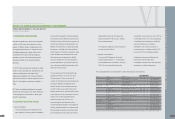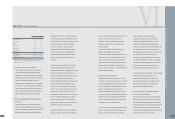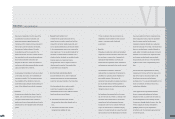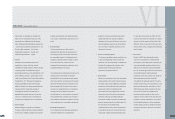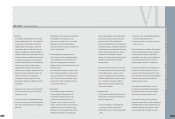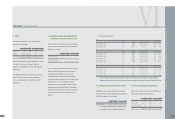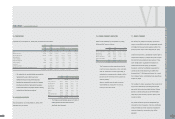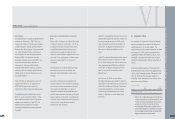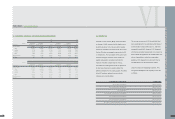HTC 2007 Annual Report Download - page 86
Download and view the complete annual report
Please find page 86 of the 2007 HTC annual report below. You can navigate through the pages in the report by either clicking on the pages listed below, or by using the keyword search tool below to find specific information within the annual report.
AN OVERVIEW OFTHE COMPANY'S FINANCIAL STATUS
167166
Those investments that are noncurrent are
classified as bond investments with no active
market - noncurrent under funds and
investments.
> Prop
e
r
t
i
e
s
Properties are stated at cost less accumulated
depreciation. Interest incurred in connection with
the purchase or construction of properties is
capitalized. Major additions, renewals and
betterments are capitalized, while maintenance
and repairs are expensed in the period incurred.
On the balance sheet date, assets are
evaluated for any impairment. If impairment is
identified, the Company should evaluate the
recoverable amount of the assets. An
impairment loss should be recognized whenever
the recoverable amount of the properties is
below carrying amount, and this loss should be
charged to current income.
An impairment loss recognized in prior years
can be reversed only if there is a change in the
estimates used to determine the recoverable
amount since the last impairment loss was
recognized. However, the amount reversed is
only to the extent that the increased carrying
amount of an asset should not exceed the asset
carrying amount (net of depreciation) that would
have been determined had no impairment loss
been recognized in prior years. An impairment
loss of an asset revalued under certain
regulations should be treated as a revaluation
increment decrease. A reversal of an impairment
loss on a revalued asset is credited directly to
equity under the heading revaluation increment.
However, to the extent that an impairment loss
on the same revalued asset was previously
recognized as profit or loss, a reversal of that
impairment loss is also recognized as profit or
loss.
Assets held under capital leases are initially
recognized at the lower of their fair value at the
start of the lease or the present value of all
future lease payments plus the bargain
purchase price. The corresponding liability to the
lessor is included in the balance sheet as a
capital lease obligation.
Lease payments are apportioned between
finance charges and reduction of the lease
obligation to have a constant rate of interest on
the remaining balance of the liability. Finance
charges are charged directly to gain or loss. But
if these charges are directly attributable to
qualifying assets, they are capitalized in
accordance with the Company's general policy
on borrowing costs.
VI
Revenue is measured at the fair value of the
consideration received or receivable and
represents amounts agreed between the
Company and the customers for goods sold in
the normal course of business, net of sales
discounts and volume rebates. For trade
receivables due within one year from the
balance sheet date, since the nominal value of
the consideration to be received approximates
its fair value and sales transactions are
frequent, the fair value of the consideration is
not determined by discounting all future receipts
using an imputed rate of interest.
An allowance for doubtful accounts is provided
on the basis of a review of the collectibility of
accounts receivable. The Company assesses
the probability of the collection of accounts
receivable by aging analysis and assessing the
value of the collaterals provided by customers.
> Inv
e
n
t
or
i
e
s
Inventories are stated at the lower of cost or
market. Cost is determined using the moving-
average method. Market value is based on
replacement costs of raw materials and work-in-
process and on net realizable values of finished
goods.
>
F
i
n
a
n
c
i
a
l
Ass
e
t
s C
a
rr
i
e
d A
t
Cos
t
Investments in equity instruments with no
quoted prices in an active market and with fair
values that cannot be reliably measured, such
as non-publicly traded stocks and stocks traded
in the emerging stock market, are measured at
their original cost. The accounting treatment for
dividends on financial assets carried at cost is
similar to that for dividends on available-for-sale
financial assets. An impairment loss is
recognized when there is objective evidence
that the asset is impaired. A reversal of this
impairment loss is disallowed.
> Bond Inv
e
s
t
m
e
n
t
s w
i
t
h No A
c
t
i
v
e
M
a
r
k
e
t
Bond investments with no active market are
stated at amortized cost and are classified as
current or noncurrent based on their maturities.
Bond investments with no active market -
current are investments paying fixed or
determinable amounts. Other features of these
bond investments are as follows:
a. The bond investments have not been
designated as at fair value through profit or
loss.
b. The bond investments have not been
designated as available for sale.
FINANCEI CONSOLIDATED REPORT
l


